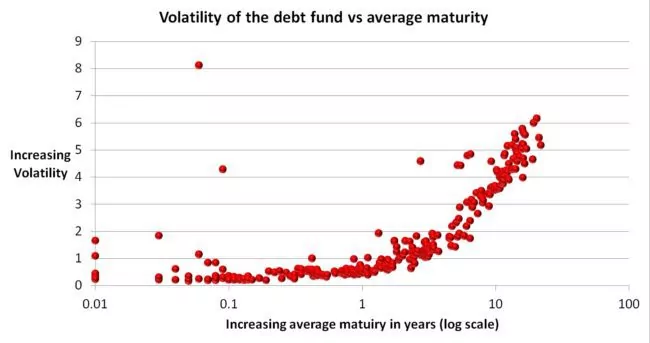Last Updated on September 27, 2023 at 3:53 pm
In the second part of the introductory series on debt mutual funds, a non-technical discussion of the aspects to consider before buying units of a debt mutual fund. You will be surprised as to how many people buy and then worry about these aspects.
The first part is here: What is a Debt Mutual Fund? -meant for absolute beginners. If you have not read that, I strongly recommend that you do and then head back here.
Update: You Can be Rich Too With Goal-Based Investing is now 23% Off at Rs 307 (Hard Cover). Get it now from Amazon It has a detailed section on how to select equity and debt mutual funds with nine online calculator modules.
If you have already purchased the book, do check out the: Resources for You Can be Rich Too with Goal-based investing
Join 32,000+ readers and get free money management solutions delivered to your inbox! Subscribe to get posts via email! (Link takes you to our email sign-up form)
🔥Want to create a complete financial plan? Learn goal-based investing? Exclusive access to our DIY tools? Increase your income with your skills? Use this link to enjoy massive discounts on our robo-advisory tool & courses! 🔥
In the first part, I had mentioned that debt mutual funds buy bonds, just like an equity mutual fund buys stocks.
A bond is a contract between two parties. The person or agency which borrows money, issues a bond certificate agreeing to pay interest at some defined interval – each month, quarter or year. In the case of a debt mutual fund, the lender is the fund manager on our behalf.
We now know that changes in the credit rating of the borrower and changes in interest rates of new bonds in the market affect the current market value of the bond and therefore the NAV of the mutual fund which holds such a bond.
Assuming that the credit rating and interest rates are constant for a period of time, how does the NAV of a debt mutual fund increase?
To understand, we need to become familiar with a bond concept known the as yield or yield to maturity to be specific. I shall discuss this in detail in the next part of this series. For now, we shall refer to this as the return obtained if the interest payments are reinvested and if the bond is held until maturity.
Here “return” = internal rate of return = IRR =XIRR. If you are curious to know more, you can check out: How to buy tax-free bonds in the secondary market.
If the yield to maturity (YTM) of a bond is currently 10%, then the NAV of a mutual fund will increase by 10%/365 = 0.03% each day. That is the interest payments are factored into the daily NAV. This type of NAV gains is known accrual income and is present in all mutual funds for each business day.
On top of this is the change in NAV due to capital gains
capital gains (when interest rates fall and/or credit rating improves)
capital losses (when interest rates increase and/or credit rating declines).
Here credit rating refers to that of any bond issues by a non-government agency. The credit rating of govt bonds cannot be rated as this is the reference. Of course one can compare credit worthiness of Indian Govt bonds with that of US govt bonds.
Trivia: In the early nineties, the Indian Govt was close to bankruptcy. This is the reason why EPF and PPF rates were 12% then – nothing to rejoice! Read more: The evolution of Public Provident Fund (PPF) Interest Rates
Consider two borrowers A and B. A has a gambling problem and B is clean. If you wish to lend money, who will you lend with peace of mind?
Obviously to B. But B is a clean-cut individual with a high probability of repayment. So he can demand a lower interest rate. If you wish to give money to A, you will demand a higher rate.
Thumb rule 1: Higher the credit rating, lower the returns, but better the peace of mind and vice versa. If PPF rates fall below 8%, we should rejoice at the health of the economy – if
Thumb rule 2: five star rated debt mutual fund could well be taking more risk by buying bonds of lower credit quality. So it is important to ignore these ratings and look carefully.
A debt mutual fund investor should be aware of where a fund is likely to invest before buying fund units. This can be understood with two quantities associated with the debt fund portfolio:
The average maturity
If there are three bonds A, B, and C with tenures of 2,3,4 years and the fund holds 20%, 50% and 30% of each respectively,
The avg. maturity = (2 x 20%)+ (3 x 50%) + (4 x 30%).
The average credit rating. A similar definition but in terms of individual credit ratings of the bonds. A bond AAA rating is more trustworthy (theoretically, did you see/read “the big short”?! ) than a bond with AA or A rating.
Key information
Higher the average maturity, more sensitive the debt fund is to interest rate changes and longer it would take for it to recover.
Why? Suppose you buy in Jan 2017, two bonds 1Y and 10Y.
1Y matures in one Y and 10Y in 10 years.
After 6 months, fresh 1Y and 10Y bonds are available at a higher interest rate. Which are you likely to selll first, 1Y or 10Y?
Obviously 10Y, because you do not wish to earn lower interest income for next 9.5 years. But by the same token, which price will fall more, 1Y or 10Y?
Again it is 10Y. There are other aspects to bond-selling that I will discuss later. For now, all we need to know is,
higher the average maturity (in years) of a debt fund, the more volatile it will be to both interest rate and credit rating changes.
If a 5-year “AA” rated bond is degraded to “BB”, one year after the issue the fall in market value would be higher than for a 1-year bond from the same downgraded issuer.
Both types of risk, interest risk and credit risk co-exists at all times. The primary cause for volatility is demand and supply. Often, more than average buying or selling in anticipation of an event (eg. rate cut) can also change the NAV at a rapid click.
The key takeaway from this post: watch out for the average maturity and average credit rating. This is already at a 1000 words so I will use these two ideas to classify debt funds in the next part, but will conclude with this graph.

Notice that with an increase in average maturity of the debt fund portfolio, the volatility increases. Therefore, I alway recommend sticking to funds with less than 1Y average maturity and good credit quality. One can buy risky corporate bonds via the debt fund route and minimise the associated risk. More on this later.
For the same avg. maturity, there are both low volatile funds and high volatile funds. This is because of the credit quality of the bonds that they hold. If interest rates fluctuated a lot, then so will the NAV. If any of the bonds were upgraded or downgraded, it will show in the NAV.
Even if a fund holds 100% of low-quality bonds and their ratings did not change, and the issuer honoured the interest rate payments, the NAV is unlikely to fluctuate a lot (assuming no abnormal buying and selling).
Volatility here is measured by calculating how much each monthly return deviated from the average return taken over a 3Y period. This is known as the standard deviation.
Trivia: Value Research included the above information after Anish Mohan complained to them citing this post: Dear Value Research, duration matters!
If you do not wish to wait for the next part and learn more right away, do consult these posts:
Debt Mutual Funds: Risk vs. Reward
Debt Mutual Fund Investments: Minimizing Risk
How to choose debt mutual funds with no credit risk and low volatility
Before you judge me too harshly, please note that I have already covered the ideas mentioned in the post before. This is a re-telling for beginners.
You Can Be Rich Too
My new book with PV Subramanyam, published by CNBC TV 18
The book comes with 9 online calculator modules to create your own financial plan.
It also has detailed selection guides for equity and debt mutual funds.
Amazon Rs. 307
Kindle (Rs 244.30)
Infibeam Rs 307
Googe Play Books App Store (Rs 244.30)
What Readers Say
- Simple and powerful This book empowers the reader with the concepts in easy to understand & simple form. Those who have been reading blogs of both authors would know that they are not only good with finance domain but also have a knack of simplifying the methods of investing for their readers. This book by them is a gem of financial knowledge for people who are starting to invest or want to get better at it. The presentation and the thought process with calculators is extremely powerful.The book should be read & calculators used simultaneously to understand the concepts well. The calculators when used with real inputs will show you where you are & where you need to reach for each of your goals. Don’t ignore these numbers.Learnings from Chapters 7 to 11 will help you avoid going off path & saving your money from financially hazardous products. With discipline & right approach suggested here you wouldn’t need a financial advisor to build wealth.
- This is perfect book on personal finance. Very nicely explained about taxation about debt mutual fund. Topics like early investing and asset allocation are very well explained. – Mahesh Deshmukh
- Highly Recommended For anyone who wishes to take control of his/her finance this book is a must read. Very simply put, even an amateur in finance will be able to understand and implement. The author genuinely attempts to inculcate the habit of investing among the people who have the ability to invest but refrain from doing it, either due to lack of time , interest or understanding!. The message from the book is ” Investment done without setting a goal/ objective is like leaving for a trip without knowing the destination, not everytime the end result will be promising. Hence, it’s important to invest in a planned & disciplined manner.” A read is highly recommended ??
- A must book for everyone who wants to take control of personal finance. Nice explanation of how a debt mutual fund works. Bonds trading and indexation benefits in high inflation years were something new I learnt. After reading this book you will be able to easily choose any funds, because you will know what that fund does or how that fund works
Read all reviews here: Amazon Reviews

Use our Robo-advisory Tool to create a complete financial plan! ⇐More than 3,000 investors and advisors use this! Use the discount code: robo25 for a 20% discount. Plan your retirement (early, normal, before, and after), as well as non-recurring financial goals (such as child education) and recurring financial goals (like holidays and appliance purchases). The tool would help anyone aged 18 to 80 plan for their retirement, as well as six other non-recurring financial goals and four recurring financial goals, with a detailed cash flow summary.
🔥You can also avail massive discounts on our courses and the freefincal investor circle! 🔥& join our community of 8000+ users!
Track your mutual funds and stock investments with this Google Sheet!
We also publish monthly equity mutual funds, debt and hybrid mutual funds, index funds, and ETF screeners, as well as momentum and low-volatility stock screeners.
You can follow our articles on Google News

We have over 1,000 videos on YouTube!

Join our WhatsApp Channel



- Do you have a comment about the above article? Reach out to us on Twitter: @freefincal or @pattufreefincal
- Have a question? Subscribe to our newsletter using the form below.
- Hit 'reply' to any email from us! We do not offer personalised investment advice. We can write a detailed article without mentioning your name if you have a generic question.
Join 32,000+ readers and get free money management solutions delivered to your inbox! Subscribe to get posts via email! (Link takes you to our email sign-up form)
About The Author
 Dr M. Pattabiraman (PhD) is the founder, managing editor and primary author of freefincal. He is an associate professor at the Indian Institute of Technology, Madras. He has over 13 years of experience publishing news analysis, research and financial product development. Connect with him via Twitter(X), LinkedIn, or YouTube. Pattabiraman has co-authored three print books: (1) You can be rich too with goal-based investing (CNBC TV18) for DIY investors. (2) Gamechanger for young earners. (3) Chinchu Gets a Superpower! for kids. He has also written seven other free e-books on various money management topics. He is a patron and co-founder of “Fee-only India,” an organisation promoting unbiased, commission-free, AUM-independent investment advice.
Dr M. Pattabiraman (PhD) is the founder, managing editor and primary author of freefincal. He is an associate professor at the Indian Institute of Technology, Madras. He has over 13 years of experience publishing news analysis, research and financial product development. Connect with him via Twitter(X), LinkedIn, or YouTube. Pattabiraman has co-authored three print books: (1) You can be rich too with goal-based investing (CNBC TV18) for DIY investors. (2) Gamechanger for young earners. (3) Chinchu Gets a Superpower! for kids. He has also written seven other free e-books on various money management topics. He is a patron and co-founder of “Fee-only India,” an organisation promoting unbiased, commission-free, AUM-independent investment advice.Our flagship course! Learn to manage your portfolio like a pro to achieve your goals regardless of market conditions! ⇐ More than 3,500 investors and advisors are part of our exclusive community! Get clarity on how to plan for your goals and achieve the necessary corpus no matter the market condition!! Watch the first lecture for free! One-time payment! No recurring fees! Life-long access to videos! Reduce fear, uncertainty and doubt while investing! Learn how to plan for your goals before and after retirement with confidence.
Increase your income by getting people to pay for your skills! ⇐ More than 800 salaried employees, entrepreneurs and financial advisors are part of our exclusive community! Learn how to get people to pay for your skills! Whether you are a professional or small business owner seeking more clients through online visibility, or a salaried individual looking for a side income or passive income, we will show you how to achieve this by showcasing your skills and building a community that trusts and pays you. (watch 1st lecture for free). One-time payment! No recurring fees! Life-long access to videos!
Our book for kids: “Chinchu Gets a Superpower!” is now available!


Must-read book even for adults! This is something that every parent should teach their kids right from their young age. The importance of money management and decision making based on their wants and needs. Very nicely written in simple terms. - Arun.Buy the book: Chinchu gets a superpower for your child!
How to profit from content writing: Our new ebook is for those interested in getting a side income via content writing. It is available at a 50% discount for Rs. 500 only!
Do you want to check if the market is overvalued or undervalued? Use our market valuation tool (it will work with any index!), or get the Tactical Buy/Sell timing tool!
We publish monthly mutual fund screeners and momentum, low-volatility stock screeners.
About freefincal & its content policy. Freefincal is a News Media organisation dedicated to providing original analysis, reports, reviews and insights on mutual funds, stocks, investing, retirement and personal finance developments. We do so without conflict of interest and bias. Follow us on Google News. Freefincal serves more than three million readers a year (5 million page views) with articles based only on factual information and detailed analysis by its authors. All statements made will be verified with credible and knowledgeable sources before publication. Freefincal does not publish paid articles, promotions, PR, satire or opinions without data. All opinions will be inferences backed by verifiable, reproducible evidence/data. Contact Information: To get in touch, please use our contact form. (Sponsored posts or paid collaborations will not be entertained.)
Connect with us on social media
- Twitter @freefincal
- Subscribe to our YouTube Videos
- Posts feed via Feedburner.
Our publications
You Can Be Rich Too with Goal-Based Investing
 Published by CNBC TV18, this book is designed to help you ask the right questions and find the correct answers. Additionally, it comes with nine online calculators, allowing you to create custom solutions tailored to your lifestyle. Get it now.
Published by CNBC TV18, this book is designed to help you ask the right questions and find the correct answers. Additionally, it comes with nine online calculators, allowing you to create custom solutions tailored to your lifestyle. Get it now.Gamechanger: Forget Startups, Join Corporate & Still Live the Rich Life You Want
 This book is designed for young earners to get their basics right from the start! It will also help you travel to exotic places at a low cost! Get it or gift it to a young earner.
This book is designed for young earners to get their basics right from the start! It will also help you travel to exotic places at a low cost! Get it or gift it to a young earner.Your Ultimate Guide to Travel
 This is an in-depth exploration of vacation planning, including finding affordable flights, budget accommodations, and practical travel tips. It also examines the benefits of travelling slowly, both financially and psychologically, with links to relevant web pages and guidance at every step. Get the PDF for Rs 300 (instant download)
This is an in-depth exploration of vacation planning, including finding affordable flights, budget accommodations, and practical travel tips. It also examines the benefits of travelling slowly, both financially and psychologically, with links to relevant web pages and guidance at every step. Get the PDF for Rs 300 (instant download)